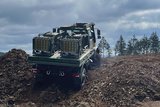New digital version of Elisra's Tactical Video and Data Link to be supplied to the US military
Elisra today announced that a new, digital version of its highly successful Tactical Video and Data Link - TVDL (AN/ACQ-9) system, designed to specifications characterized together with a US customer, is in advanced development stages. The current-generation analogue TVDL, which is already fielded and operational on dozens of combat helicopters, is known to have dramatically improved the hit rate of aircrews.
By receiving real-time video and telemetry data from UAV payloads and relaying the information to other aircraft and to forces on the ground, the TVDL enables creating a common visual language amongst all players in the battlespace, enhancing their situational awareness and helping them to quickly and effectively close the sensor-to-shooter loop. Gunship pilots can relay visual intelligence to commanders on the ground and receive the "clear to shoot" almost instantly.
Speaking about the new digital version of the TVDL, Avi Peleg , Senior Director Marketing & Sales, at Elisra's Communications & Datalinks division, said that after a relatively short experience of operating the TVDL system in the theater, many branches of the US military have shown interest in the system. Peleg anticipates that new trials and demonstrations with the system will take place in the US in the near future.
The TVDL is an advanced video and data receiver/transmitter system especially designed for installation on combat helicopters. Very compact and low-weight (P-kit weights only 2.8 kilograms), the system easily fits even in the most cramped cockpits and enables real-time, broadcast-quality video imagery and data captured by UAV payloads or ground-based sensors to be displayed directly in front of the aircrew, saving the need for lengthy and cumbersome radio dialogue with a Ground Control Station.
As a true video relay, the system can simultaneously transmit the received video and data, and deliver imagery captured by onboard payloads to tactical forces in the battlespace, for enhanced co-ordination and battle management. Video and data can be relayed to a variety of users, including other helicopters, ground forces, Combat Information Centers, and the like. Operating at L, S or C band, the system is equipped with a variety of antennas for enhanced receive/transmit range coverage and superior intelligibility.
The TVDL augments current systems by giving helicopter pilots video data from off-board sensors that reduce target identification times and improve precision targeting capability. This video link reduces the helicopter's exposure to battlefield threats, and increases standoff distances from those threats as critical airborne attack tactics and engagement scenarios are formulated. The TVDL also supports advance video display of Forward Arming and Refueling Points (FARPs). Thus, the video link improves precision strike and reduces operational risks associated with the attack helicopter mission.
Source: Elisra
Follow Shephard News on Twitter
Related Equipment in Defence Insight
More from Digital Battlespace
-
![Babcock nears first customer for Nomad AI translation tool]()
Babcock nears first customer for Nomad AI translation tool
Nomad can provide militaries with real-time intelligence, saving critical time on the battlefield.
-
![AUSA 2025: Israel’s Asio Technologies to supply hundreds of improved Taurus tactical systems]()
AUSA 2025: Israel’s Asio Technologies to supply hundreds of improved Taurus tactical systems
Taurus operates alongside the Israel Defense Forces’ Orion system which supports mission management across tens of thousands of manoeuvring forces, from squad leaders to battalion commanders.
-
![AUSA 2025: Kopin pushes micro-LED plans as China moves faster]()
AUSA 2025: Kopin pushes micro-LED plans as China moves faster
The plan for the new displays follows fresh investment in Kopin’s European facilities by Theon and an order for head-up displays in fielded aircraft, with funding from the US Department of Defense.
-
![AUSA 2025: Persistent Systems to complete its largest order by year’s end]()
AUSA 2025: Persistent Systems to complete its largest order by year’s end
Persistent Systems received its largest ever single order for its MPU5 devices and other systems earlier this month and has already delivered the 50 units to the US Army’s 4th Infantry Division.
-
![Aselsan brings in dozens of companies and systems under the Steel Dome umbrella]()
Aselsan brings in dozens of companies and systems under the Steel Dome umbrella
Turkey has joined the family of countries attempting to establish a multilayered air defence system with government approval in August 2024 for the effort landed by Aselsan. Dubbed Steel Dome, the programme joins Israel’s Iron Dome, the US Golden Dome, India’s Mission Sudarshan Chakra and South Korea’s low-altitude missile defence system.
-
![DSEI 2025: MARSS unveils new agnostic multidomain C4 system]()
DSEI 2025: MARSS unveils new agnostic multidomain C4 system
MARSS’ NiDAR system has been deployed using sensors from static platforms to provide detection and protection for static sights, such as critical infrastructure, ports and military bases.



























